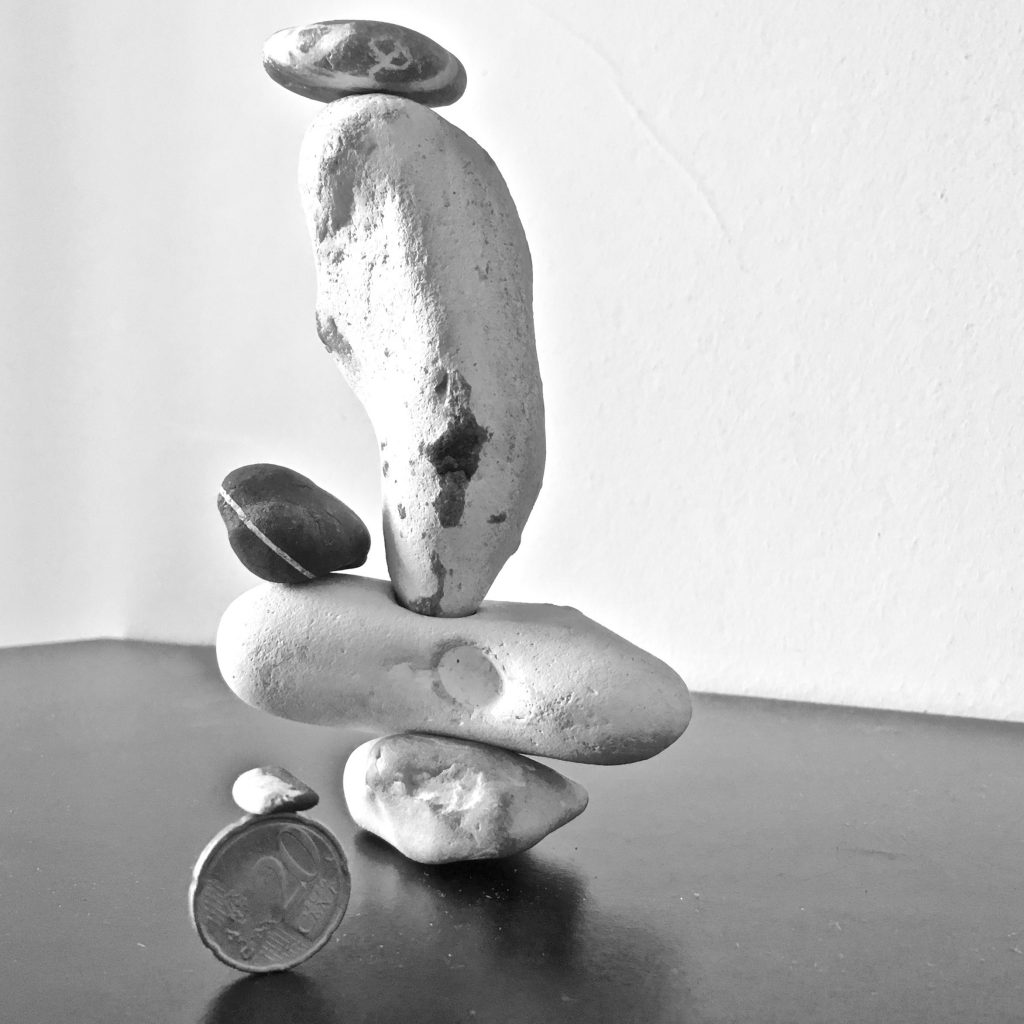Stapeleien // stackings
„Stapeleien“ sind eines meiner Hobbys …
… Meistens Steine, oft aber auch Hölzer, Strandgut oder irgendwelche Gegenstände werden übereinandergestapelt oder anders in eine Balance gebracht, das Ergebnis ist etwas, was ich „Skulptur“ nenne – aber ohne Kunstanspruch.
Natürlich versuche ich, beim zum Beispiel Steinstapeln nicht die leichteste Form zu wählen (flach auf flach), sondern schon eine, die eine gewisse Herausforderung darstellt, z. B., bei der die Auflagepunkte sehr klein und/oder konvex, also nach außen gewölbt sind. Ein auf der Spitze stehender Stein sieht eben viel spannender aus als ein auf der Breitseite ruhender – es sei denn, der Stein darunter ist spitz. Diese Balance herzustellen ist gleichzeitig eine Übung in Geduld, Konzentration und Feingefühl und wenn eine schwierige Skulptur gelingt, ist die Freude natürlich entsprechend groß – vor allem, wenn sie hält und nicht gleich wieder zusammenfällt 😉
Geht draußen und drinnen
Weil es mir so viel Spaß macht, übe ich mein Hobby aus, wo und wann immer es sich ergibt. Gerne natürlich draußen, am liebsten am (Stein-)Strand, aber ich habe auch zuhause im Treppenhaus ein paar Steinchen liegen – manchmal legt auch ein*e Bewohner*in etwas dazu – die ich immer wieder neu kombiniere, wenn möglich natürlich mit allen Teilen und möglichst vielen davon direkt übereinander und möglichst hoch. Hoch stapeln ist hier erwünscht und erstrebenswert, im Gegensatz zum sonstigen „Hochstapeln“ (um ein Beispiel für den Unterschied von Getrennt- und Zusammenschreibung zu geben; ich kann halt den Ex-Deutschlehrer nicht verleugnen). Trotzdem gehe ich meine Versuche eher spielerisch als nach Meisterschaft strebend an und nenne sie deshalb „Stapeleien“.
Profis
Wen das Thema interessiert, der kann zum Beispiel auf Wikipedia darüber nachlesen und den Links zu bekannten Steinbalance-Künstlern folgen. Der dort erstgenannte – Andy Goldsworthy – ist ein Landart-Künstler, dessen Bücher und Filme ich gerne allen ans Herz legen möchte, die einen Sinn für so etwas haben (die Bilder googeln oder bei YouTube die Trailer ansehen gibt natürlich auch schon einen guten Eindruck). Ich finde seine Arbeiten unglaublich poetisch und feinsinnig, sie sprechen mich sehr tief an.
Selbst ausprobieren!
Aber jede*r kann die Erfahrung machen, sich einem scheinbar banalen Objekt wie einem Stein zu nähern, ihn zu erforschen (zum Beispiel: Wie viele Arten gibt es, ihn auf eine ebene Fläche zu legen oder stellen?) und beim Stapeln zu fühlen, wo genau sein Schwer- und Kipppunkt liegt, wie er mit dem Untergrund in Kontakt ist, wo die Reibung im Verbund mit der Schwerkraft eine Stellung ermöglicht, die dem Gewöhnlichen entrückt ist.
Es ist eine wunderbare Übung in Geduld, Gelassenheit und innerer Ruhe –und macht Freude!
English: “Stacking” is one of my hobbies …
… Mostly stones, but often also woods, flotsam or any kind of objects are stacked on top of each other or otherwise brought into balance, the result is something I call “sculpture” – but without any artistic claim.
Of course, when stacking stones, for example, I try not to choose the lightest form (flat on flat), but one that is already a certain challenge, e.g. where the support points are very small and/or convex, i.e. curved outwards. A stone standing on its tip looks much more exciting than one resting on its broad side – unless the stone below is pointed. To achieve this balance is at the same time an exercise in patience, concentration and sensitivity, and when a difficult sculpture succeeds, the joy is naturally correspondingly great – especially if it holds and does not collapse again immediately 😉
Works outside and inside
Because I enjoy it so much, I practice my hobby wherever and whenever it arises. Of course I like to do it outside, preferably at the (stone) beach, but I also have some stones at home in the staircase – sometimes onee inhabitant puts something on top of it – which I combine again and again, if possible of course with all parts and as many of them as possible directly above each other and as high as possible. Piling them high is desired and desirable here, in contrast to the other “piling them high” (to give an example of the difference between writing them separately and together; I just can’t deny the German teacher). Nevertheless, I approach my attempts playfully rather than striving for mastery and therefore call them “stacking”.
Professionals
If you are interested in the topic, you can read about it on Wikipedia for example and follow the links to well-known Steinbalance artists. The former – Andy Goldsworthy – is a landart artist whose books and films I would like to recommend to anyone who has a sense for such things (of course, Google the pictures or watch the trailers on YouTube gives a good impression). I find his works incredibly poetic and subtle, they appeal to me very deeply.
Try it yourself!
But anyone can have the experience of approaching a seemingly banal object like a stone, exploring it (for example: How many ways are there to place it on a flat surface?) and, when stacking it, to feel where exactly its centre of gravity and tipping point is, how it is in contact with the ground, where friction in combination with gravity allows a position that is far removed from the ordinary.
It is a wonderful exercise in patience, calmness and inner peace – and brings joy!
Translated with www.DeepL.com/Translator (free version)
Flur-Stapeleien //
corridor stacking

Skater? 



Pinguin? 





























